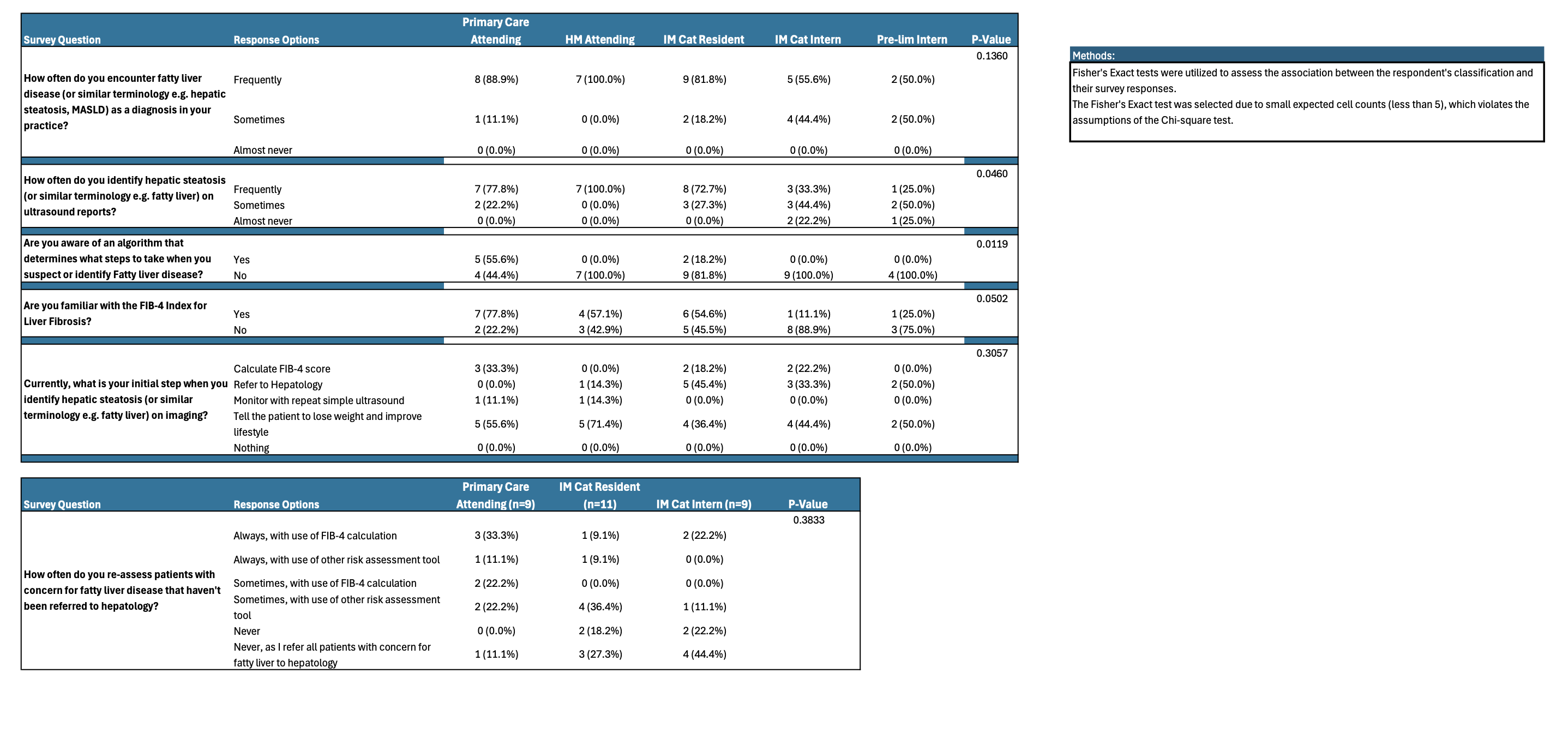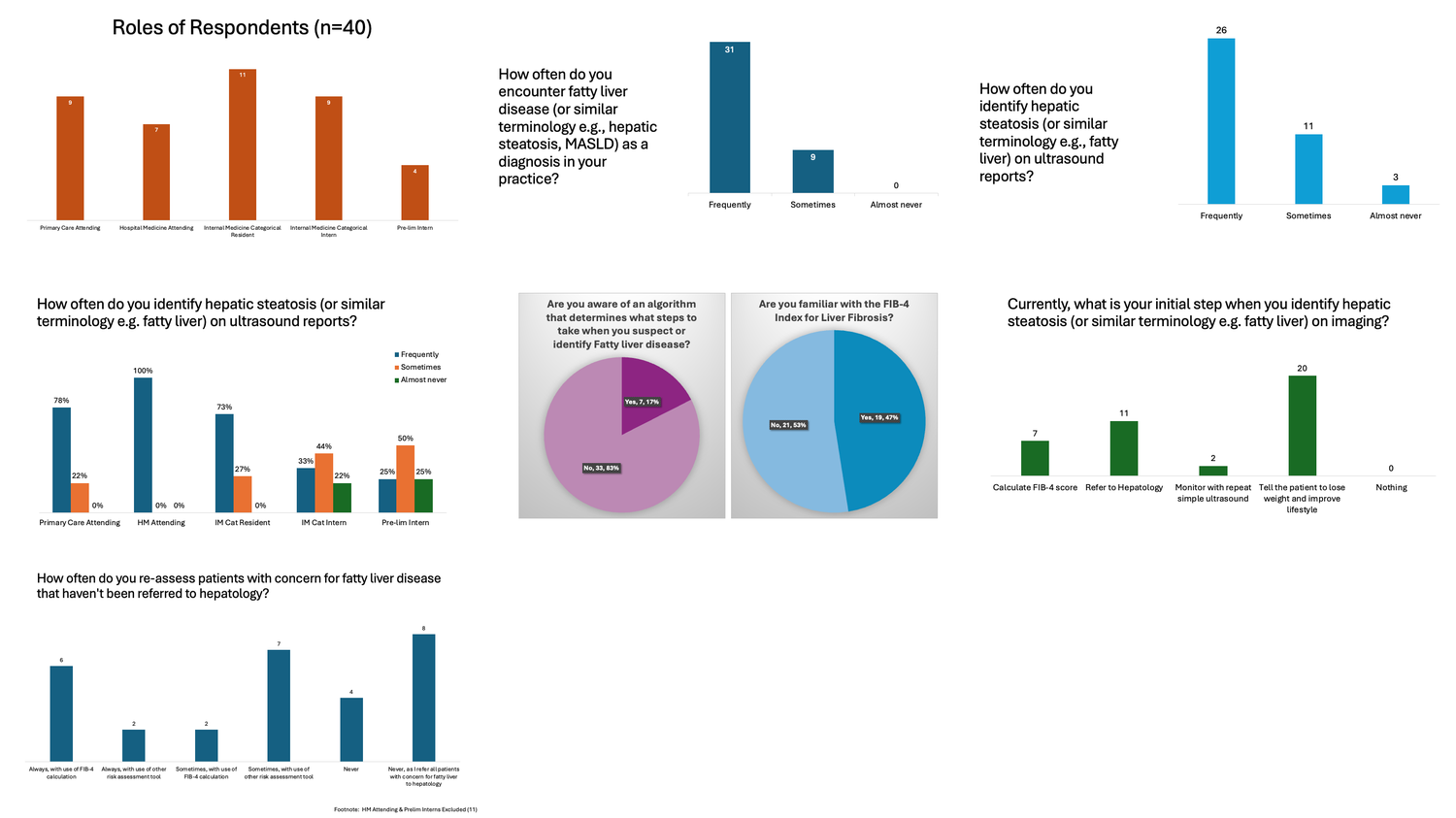Tuesday Poster Session
Category: Liver
P5827 - Examining Non-Hepatology Physicians' Understanding and Adherence to MASLD Primary Risk Assessment Guidelines: A Survey-Based Approach
Tuesday, October 28, 2025
10:30 AM - 4:00 PM PDT
Location: Exhibit Hall
.jpg)
Ruona Ebiai, MD
Ochsner Health Clinic Foundation
New Orleans, LA
Presenting Author(s)
Ruona Ebiai, MD, Jasmine McNair, MD, Sameera Shuaibi, MD, Nigel Girgrah, MD, PhD, George Therapondos, MBChB, MPH, Erin Biggs, PhD, MPH
Ochsner Health Clinic Foundation, New Orleans, LA
Introduction: Metabolic Dysfunction-Associated Steatotic Liver Disease (MASLD) is among the leading causes of chronic liver disease and is rapidly becoming one of the most frequent indications for liver transplantation. Given the recent FDA approval of resmetirom, it is important, now more than ever before, to ensure the appropriate patients are screened and selected for therapy and specialist care. This project aims to analyze a diverse group of non-hepatology Physicians’ understanding and adherence to current MASLD Primary Risk Assessment Guidelines.
Methods: A questionnaire was distributed to 143 physicians via an e-mailed REDcap link. 40 complete responses were received (response rate of 28%) from a group which included Primary care staff, Hospital medicine staff, Internal medicine categorical and Preliminary resident physicians. Questions specifically targeted physicians’ familiarity, comfortability and knowledge of primary risk-assessment for MASLD. Fisher's Exact tests were utilized to assess the association between the respondent's roles and their survey responses.
Results: 77.5% of participants highlighted that they encountered MASLD “frequently” in their practice while 22.5% encountered MASLD “sometimes”. 82.5% of participants were NOT aware of an algorithm that assisted to determine next steps when fatty liver disease is suspected. 52.5% of participants were NOT familiar with the FIB-4 index for liver fibrosis. Only 17.5% of respondents correctly identified calculation of FIB-4 as the initial step when fatty liver disease is suspected. Overall, responses suggested that while the condition was frequently encountered, there was a lack of awareness regarding the need to assess for significant fibrosis.
Discussion: These findings underscore a persistent gap in frontline recognition of fibrosis risk stratification in MASLD. Although many clinicians report frequent encounters with the condition, there appears to be limited awareness that FIB-4 is the recommended first step in evaluating for significant fibrosis. Without this critical step, low-risk patients may be referred unnecessarily, while those with advanced disease risk being missed entirely. This not only strains specialty resources but may delay appropriate care for those who need it most. Improved education around MASLD algorithms, particularly the role of non-invasive tools like FIB-4, is essential to optimizing referral patterns and patient outcomes.

Figure: MASLD Risk-assessment survey question and response table

Figure: MASLD Risk-assessment survey question and response graphs
Disclosures:
Ruona Ebiai indicated no relevant financial relationships.
Jasmine McNair indicated no relevant financial relationships.
Sameera Shuaibi indicated no relevant financial relationships.
Nigel Girgrah indicated no relevant financial relationships.
George Therapondos indicated no relevant financial relationships.
Erin Biggs indicated no relevant financial relationships.
Ruona Ebiai, MD, Jasmine McNair, MD, Sameera Shuaibi, MD, Nigel Girgrah, MD, PhD, George Therapondos, MBChB, MPH, Erin Biggs, PhD, MPH. P5827 - Examining Non-Hepatology Physicians' Understanding and Adherence to MASLD Primary Risk Assessment Guidelines: A Survey-Based Approach, ACG 2025 Annual Scientific Meeting Abstracts. Phoenix, AZ: American College of Gastroenterology.
Ochsner Health Clinic Foundation, New Orleans, LA
Introduction: Metabolic Dysfunction-Associated Steatotic Liver Disease (MASLD) is among the leading causes of chronic liver disease and is rapidly becoming one of the most frequent indications for liver transplantation. Given the recent FDA approval of resmetirom, it is important, now more than ever before, to ensure the appropriate patients are screened and selected for therapy and specialist care. This project aims to analyze a diverse group of non-hepatology Physicians’ understanding and adherence to current MASLD Primary Risk Assessment Guidelines.
Methods: A questionnaire was distributed to 143 physicians via an e-mailed REDcap link. 40 complete responses were received (response rate of 28%) from a group which included Primary care staff, Hospital medicine staff, Internal medicine categorical and Preliminary resident physicians. Questions specifically targeted physicians’ familiarity, comfortability and knowledge of primary risk-assessment for MASLD. Fisher's Exact tests were utilized to assess the association between the respondent's roles and their survey responses.
Results: 77.5% of participants highlighted that they encountered MASLD “frequently” in their practice while 22.5% encountered MASLD “sometimes”. 82.5% of participants were NOT aware of an algorithm that assisted to determine next steps when fatty liver disease is suspected. 52.5% of participants were NOT familiar with the FIB-4 index for liver fibrosis. Only 17.5% of respondents correctly identified calculation of FIB-4 as the initial step when fatty liver disease is suspected. Overall, responses suggested that while the condition was frequently encountered, there was a lack of awareness regarding the need to assess for significant fibrosis.
Discussion: These findings underscore a persistent gap in frontline recognition of fibrosis risk stratification in MASLD. Although many clinicians report frequent encounters with the condition, there appears to be limited awareness that FIB-4 is the recommended first step in evaluating for significant fibrosis. Without this critical step, low-risk patients may be referred unnecessarily, while those with advanced disease risk being missed entirely. This not only strains specialty resources but may delay appropriate care for those who need it most. Improved education around MASLD algorithms, particularly the role of non-invasive tools like FIB-4, is essential to optimizing referral patterns and patient outcomes.

Figure: MASLD Risk-assessment survey question and response table

Figure: MASLD Risk-assessment survey question and response graphs
Disclosures:
Ruona Ebiai indicated no relevant financial relationships.
Jasmine McNair indicated no relevant financial relationships.
Sameera Shuaibi indicated no relevant financial relationships.
Nigel Girgrah indicated no relevant financial relationships.
George Therapondos indicated no relevant financial relationships.
Erin Biggs indicated no relevant financial relationships.
Ruona Ebiai, MD, Jasmine McNair, MD, Sameera Shuaibi, MD, Nigel Girgrah, MD, PhD, George Therapondos, MBChB, MPH, Erin Biggs, PhD, MPH. P5827 - Examining Non-Hepatology Physicians' Understanding and Adherence to MASLD Primary Risk Assessment Guidelines: A Survey-Based Approach, ACG 2025 Annual Scientific Meeting Abstracts. Phoenix, AZ: American College of Gastroenterology.

